|
|
 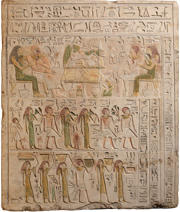
Stela of Sakherty, chamberlain Probably Abydos Middle Kingdom, 12th Dynasty, reign of Sesostris I C. 1970–1900 BC Painted limestone H. 64 cm; W. 54 cm Musée du Louvre, Department of Egyptian Antiquities Inv. E 3113 (C 196) Purchase, Anastasi collection, 1857 © 2011 Musée du Louvre / Christian Décamps The stela of 12th-Dynasty dignitary Sakherty is typical of private funerary stelae from the Middle Kingdom. These were intended to ensure their owners divine protection—in Sakherty's case that of Osiris, god of the dead—and to guarantee the eternal availability of the offerings (especially food) that they would need in order to survive in the afterlife. These stelae were usually placed at the entrance to the tomb inside the funerary chapel, which the deceased's relatives could visit; they could also be placed as a sign of devotion in cenotaphs (symbolic tombs that were not places of burial) built in the sacred cities of gods such as Osiris, in the immediate vicinity of their temples. The main register on this stela shows Sakherty, his wife beside him, sitting at a well-laden offering table, in the company of his dead parents. The two lower registers show Sakherty's relatives and household servants advancing in procession to honor the deceased with offerings of food, drink, and grave goods to place in the tomb. Inscribed texts completed the magical power of the image with offering formulas, a declaration by Sakherty, and an "appeal to the living" inviting passers-by to recite the formulas on the deceased's behalf. 
Offering table of Horiraa, chancellor to the king Saqqara, tomb of Horiraa Late Period, late 26th Dynasty C. 664–525 BC Basalt H. 12 cm; W. 82 cm; L. 60.5 cm Musée du Louvre, Department of Egyptian Antiquities Inv. E 3867 (D 65) Purchased in 1827 © 2011 Musée du Louvre / Georges Poncet The shape of this table—rectangular, with a spout—is typical of ancient Egyptian offering tables. The upper section, framed by hieroglyphic inscriptions, contains two hollowed-out basins and a low-relief decoration depicting a loaf of bread on a rolled mat (the "hetep" sign, which means "satisfaction"), two "hes" vases for water, two round loaves of bread, an ox foreleg (or "khepesh"), and a trussed goose ready for roasting. The text consists of two symmetrical royal offering formulas asking the gods Osiris and Ptah to provide sufficient nourishment for the survival of the royal chancellor Horiraa, born of Ankhor and Atumirdis. The sides of the table are inscribed with detailed lists of the offerings. The solidity of basalt was a further guarantee that the offerings of food and drink would last forever, magically ensuring the deceased's survival. In the tomb chapel, the offering table was used for funerary rituals: the priest made a libation of water, which flowed through the table's spout. 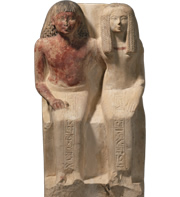
Seated group of Samut and Mutneferet Probably Thebes New Kingdom, 18th Dynasty, reign of Thutmose III C. 1479–1425 BC Painted limestone H. 37 cm; W. 19.5 cm; D. 21.5 cm Musée du Louvre, Department of Egyptian Antiquities Inv. N 54 (A 53) Purchase, Drovetti collection, 1827 © 2011 Musée du Louvre / Christian Décamps This statue depicts a couple sitting on a high-backed chair in a traditional pose: legs and feet together, each with one arm around the other and their free hand resting on their thigh. The woman, on her husband's right, wears a plain, ankle-length dress with a simple collar and a tripartite wig with a plain frontal headband. Her husband is bare-chested, and wears an ankle-length kilt and a heavy, elaborate wig; his right hand, resting on his thigh, holds a mysterious cloth. The front of the statue is broken, so the feet have disappeared. Traces of the original polychromy remain in the red ochre of Samut's skin (the conventional color for male flesh), but the yellow ochre of the woman's skin is lost. The column of inscriptions on each figure's clothing promises offerings to Samut, confectioner of Thutmose III in his mortuary temple Henketankh, and to Mutneferet, wife and mistress of the house, both of whom are "justified" (i.e., admitted into the world of the dead). Five columns of hieroglyphs on the sides of the seat promise royal offerings to each of the deceased. 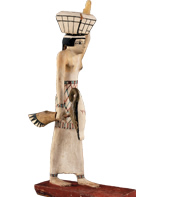
Offering-bearer Assiut, tomb of Nakht (no. 7) Middle Kingdom, 12th Dynasty C. 1963–1786 BC Painted wood H. 57.7 cm; W. 11.3 cm; L. 27.7 cm Musée du Louvre, Department of Egyptian Antiquities Inv. E 12029 Division of excavation finds © 2011 Musée du Louvre / Georges Poncet This female statuette represents an essential figure in ancient Egyptian funerary beliefs: the offering-bearer. Her role was to supply the deceased for all eternity with the food and drink he needed to survive in the afterlife. This particular offering-bearer is typical of the ones produced in Assiut in the Middle Kingdom; it was found in the tomb of chancellor Nakht, a good example of a provincial dignitary's tomb from the Middle Kingdom. This figurine, and five others like her, were prominently positioned near representations of worldly goods (tools, weapons, etc.) that the deceased might need in the afterlife, and small-scale models of, among other things, a beer brewery, a butcher's workshop, and a granary, representing the promise of food and drink for eternity. This offering-bearer of Nakht wears a long dress with straps and a bead net; she holds a live duck in her right hand, and balances a heavy basket on her head with her left. She is depicted with her left leg forward in the walking pose characteristic of offering-bearers. 
Offering plate Old Kingdom C. 2700–2200 BC Egyptian alabaster H. 10.3 cm; Diam. 41.8 cm Musée du Louvre, Department of Egyptian Antiquities Inv. N 1091 © 2011 Musée du Louvre / Georges Poncet 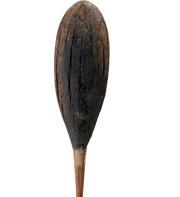
Small-scale model of a romaine lettuce Middle Kingdom-New Kingdom (?) C. 2033–1550 BC Painted wood L. 9.8 cm; Diam. 2.6 cm Musée du Louvre, Department of Egyptian Antiquities Inv. AF 8965 © 2003 Musée du Louvre / Christian Décamps 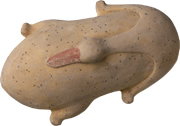
Model of a plucked and trussed goose Saqqara Old Kingdom C. 2700–2200 BC Painted limestone H. 10 cm; W. 20.6 cm Musée du Louvre, Department of Egyptian Antiquities Inv. E 16262 © 2011 Musée du Louvre / Christian Décamps This stone pedestal table was designed to hold the offerings of real food placed in the tomb by the deceased's family or by priests at the funeral or during funerary rituals. It is shown here with two representations of offerings (small-scale wood and stone models of different foods), illustrating the many different means used by the Egyptians to ensure their survival after physical death. It was believed to be as vital to eat and drink in the afterlife as on earth, and every deceased person therefore needed real or fictitious offerings at his or her disposal forever. The Egyptians believed representations to be the equivalent of real things; placing a three-dimensional model near the deceased was thus a magical means of ensuring the eternal availability of the item represented. The menu proposed here comprises a romaine lettuce (a common feature of funerary meals), recognizable by its oblong shape and long leaves (Lactuca sativa, var. longifolia), and a plucked, gutted, ready-to-roast goose, another favorite with the Egyptians. |
||